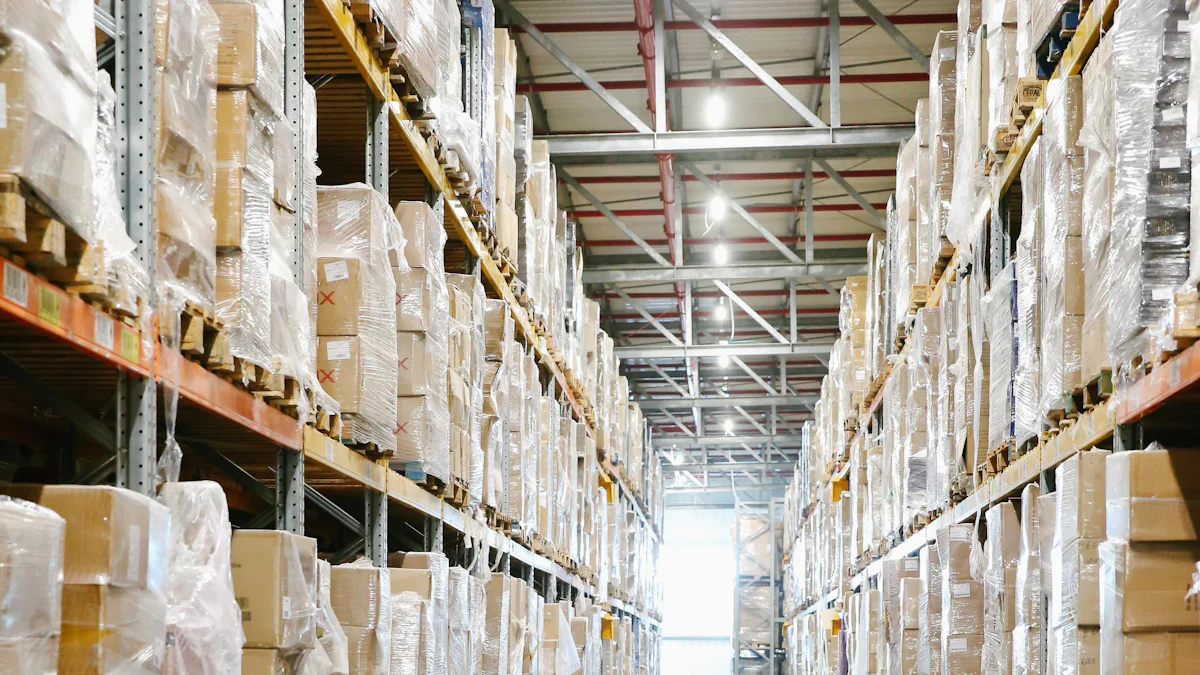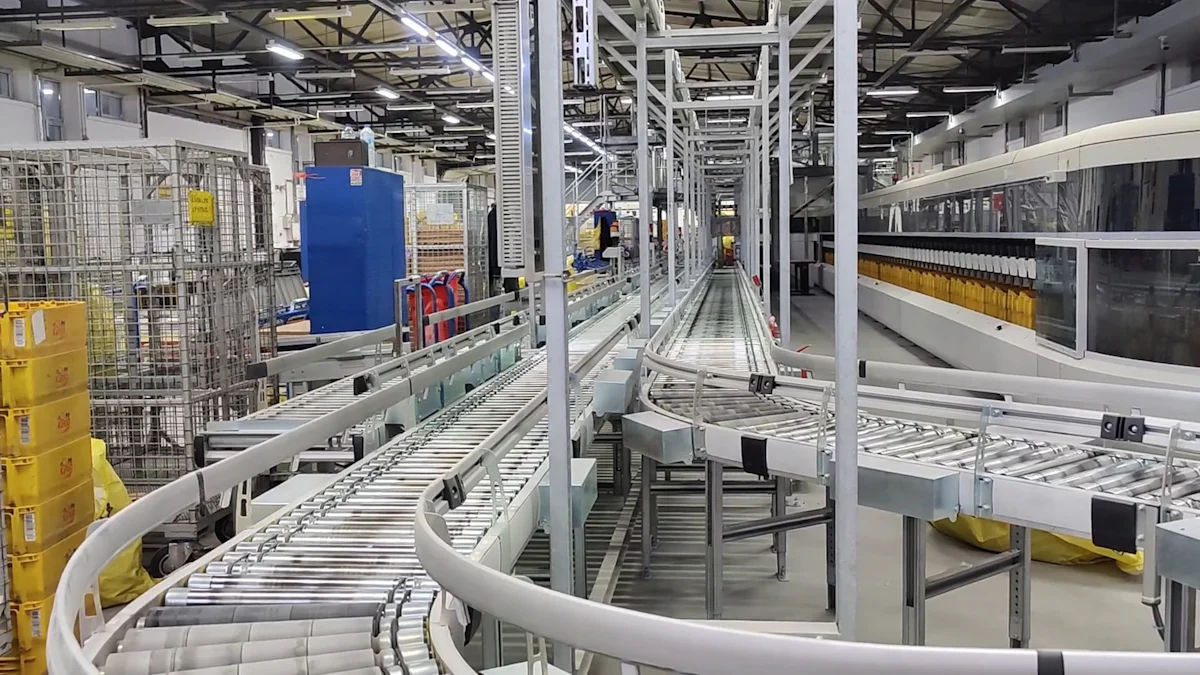Traditional Supply Chains Versus Data-Driven Models

Traditional supply chains rely on manual processes and operate in silos, often leading to inefficiencies and delays. In contrast, data-driven supply chains leverage advanced technologies like AI, IoT, and big data to enable real-time tracking, predictive analytics, and proactive decision-making. This shift transforms supply chain management into a dynamic and efficient system. Businesses adopting these models gain a competitive edge by reducing costs, improving supplier performance, and enhancing transparency. As 98% of supply chain leaders already use data for decisions, the importance of embracing data-driven methodologies cannot be overstated.
Understanding Traditional Supply Chains

Traditional supply chains have evolved over centuries, rooted in the trade practices of ancient civilizations like Mesopotamia, Egypt, Greece, and Rome. These early systems laid the foundation for modern supply chain management by establishing basic processes for procuring, manufacturing, and distributing goods. Over time, events such as the establishment of guilds and market towns during the medieval period standardized production and trade practices. The global expansion of trade during colonialism further shaped these systems, enabling long-distance commerce.
Characteristics of Traditional Supply Chains
Traditional supply chains follow a linear structure, moving goods through distinct stages. These stages typically include:
Procurement of Raw Materials: Businesses source raw materials from suppliers, often relying on long-term contracts and fixed schedules.
Manufacturing: Factories transform raw materials into finished products, adhering to predefined production plans.
Distribution and Shipping: Goods are transported to warehouses or distribution centers before reaching retailers or customers.
Sale and Consumption: Products are sold to end consumers through physical stores or other traditional channels.
These supply chains often operate in silos, with limited communication between different stages. Each segment functions independently, which can lead to inefficiencies and delays. For example, manufacturers may lack real-time data on inventory levels at distribution centers, resulting in overproduction or stockouts.
Limitations of Traditional Supply Chains
Traditional supply chains face several challenges that hinder their efficiency and adaptability:
Lack of Real-Time Data: Decision-making relies on historical data and forecasts, making it difficult to respond quickly to changes in demand or supply disruptions.
Rigid Processes: Fixed schedules and long-term contracts reduce flexibility, making it hard to adapt to market fluctuations.
Limited Collaboration: Minimal data-sharing between suppliers, manufacturers, and distributors creates inefficiencies and delays.
High Costs: Manual processes and fragmented operations increase operational expenses.
Global Complexity: Managing multi-site suppliers, manufacturers, and distributors across regions adds layers of complexity, especially with varying customs regulations and transportation challenges.
Despite these limitations, traditional supply chains remain integral to many industries. However, the growing complexity of global trade and the demand for faster, more efficient systems highlight the need for transformation. Businesses must address these challenges to remain competitive in an increasingly interconnected world.
Exploring Data-Driven Supply Chains

The evolution of supply chain management has ushered in a new era where data-driven supply chains redefine efficiency and adaptability. These modern systems leverage advanced technologies to provide real-time insights, enabling businesses to make informed decisions and optimize operations. Unlike traditional models, data-driven supply chains prioritize agility, transparency, and customer-centric strategies.
Key Technologies in Data-Driven Supply Chains
Role of AI and Predictive Analytics
Artificial Intelligence (AI) plays a transformative role in modern supply chains. By utilizing predictive analytics, businesses can forecast demand, identify potential disruptions, and optimize inventory levels. AI-driven tools analyze vast datasets to uncover patterns and trends, enabling proactive decision-making. For instance, predictive analytics helps companies anticipate seasonal demand fluctuations, ensuring adequate stock levels without overproduction. This capability reduces waste and enhances operational efficiency.
IoT and Real-Time Tracking
The Internet of Things (IoT) revolutionizes supply chain visibility. IoT-enabled sensors monitor the movement and condition of goods throughout the supply chain. These devices provide real-time data on location, temperature, and humidity, ensuring product quality and timely deliveries. For example, perishable goods like pharmaceuticals benefit from IoT tracking, as it ensures compliance with storage conditions. Real-time tracking also allows businesses to address delays or issues promptly, minimizing disruptions.
Big Data for Demand Forecasting
Big data serves as the backbone of data-driven supply chains. By analyzing historical sales data, market trends, and consumer behavior, businesses can accurately forecast demand. This approach enables precise production planning and resource allocation. For instance, retailers use big data to predict peak shopping periods, ensuring sufficient inventory to meet customer needs. Demand forecasting powered by big data reduces stockouts and enhances customer satisfaction.
Benefits of Data-Driven Supply Chains
Enhanced Visibility and Transparency
Data-driven supply chains offer unparalleled visibility across all stages of the supply chain. Real-time insights enable businesses to monitor operations, identify bottlenecks, and implement corrective actions. Transparency fosters trust among stakeholders, including suppliers, manufacturers, and customers. For example, digital supply chain platforms provide end-to-end visibility, ensuring seamless collaboration and accountability.
Real-Time Decision-Making and Agility
The ability to make real-time decisions sets data-driven supply chains apart. Businesses can respond swiftly to changes in demand, supply disruptions, or market conditions. This agility enhances competitiveness and customer satisfaction. For instance, real-time insights allow companies to reroute shipments during transportation delays, ensuring timely deliveries. Agility in decision-making minimizes risks and maximizes efficiency.
Scalability and Cost Efficiency
Data-driven supply chains support scalability by streamlining processes and optimizing resource utilization. Advanced analytics identify cost-saving opportunities, such as reducing transportation expenses or minimizing excess inventory. For example, digital supply chain platforms enable businesses to scale operations during peak seasons without compromising efficiency. Cost efficiency achieved through data-driven insights enhances profitability and sustainability.
Challenges in Implementing Data-Driven Models
Despite their advantages, data-driven supply chains face implementation challenges. Integrating advanced technologies requires significant investment in infrastructure and training. Businesses must address data security concerns to protect sensitive information. Additionally, aligning stakeholders with new processes demands effective change management strategies. Overcoming these challenges is essential to unlocking the full potential of data-driven supply chains.
Direct Comparison: Traditional vs. Data-Driven Supply Chains
Visibility and Transparency
Traditional supply chains often lack visibility due to their reliance on siloed systems and manual processes. Each stage of the supply chain operates independently, limiting the flow of information between suppliers, manufacturers, and distributors. This fragmented approach creates blind spots, making it difficult to track inventory levels or identify bottlenecks.
In contrast, data-driven supply chains excel in visibility and transparency. Real-time data sharing across all stages ensures that businesses can monitor operations with precision. For example, IoT-enabled sensors provide continuous updates on the location and condition of goods, allowing stakeholders to address potential issues before they escalate. Digital supply chain platforms further enhance transparency by offering end-to-end tracking, fostering trust and accountability among all participants.
"Enhanced visibility transforms supply chain management by enabling proactive responses to disruptions and improving overall efficiency."
Decision-Making and Insights
Decision-making in traditional supply chains often relies on intuition and historical data. This approach increases the risk of errors and delays, as it lacks the ability to adapt quickly to changing circumstances. Limited access to real-time information further hampers the ability to make informed decisions.
Data-driven supply chains revolutionize decision-making by leveraging advanced analytics and AI-powered tools. These technologies analyze vast datasets to generate actionable insights, enabling businesses to predict demand, optimize inventory, and mitigate risks. For instance, AI-driven forecasting tools accurately predict future demand by analyzing historical trends, reducing errors and ensuring optimal stock levels. Real-time insights empower organizations to make data-backed decisions, eliminating biases and enhancing operational performance.
"Data-driven decision-making shifts the focus from reactive strategies to proactive planning, delivering measurable value to stakeholders."
Agility and Responsiveness
Traditional supply chains struggle with rigidity due to fixed schedules and long-term contracts. This inflexibility makes it challenging to respond to sudden changes in demand or supply chain disruptions. Delays in communication between stages further exacerbate the problem, leading to inefficiencies and increased costs.
Data-driven supply chains prioritize agility and responsiveness. Real-time data enables businesses to adapt quickly to market fluctuations, ensuring seamless operations. For example, during transportation delays, companies can reroute shipments based on real-time updates, minimizing disruptions. Intelligent automation tools streamline planning and performance management, allowing businesses to scale operations efficiently. This adaptability positions organizations to thrive in dynamic markets while maintaining customer satisfaction.
"Agility in supply chain management is no longer optional; it is a necessity for businesses aiming to stay competitive in a rapidly evolving landscape."
Cost and Efficiency
Traditional supply chains often struggle with inefficiencies due to their reliance on manual processes and outdated data. These systems require significant human intervention, which increases operational costs and slows down decision-making. For example, inventory management in traditional models depends on periodic checks and historical data, leading to overstocking or stockouts. This lack of precision results in wasted resources and higher expenses.
In contrast, data-driven supply chains optimize cost and efficiency by leveraging advanced technologies. Real-time data enables businesses to monitor operations continuously, identify inefficiencies, and implement corrective measures promptly. For instance, predictive analytics can forecast demand accurately, reducing excess inventory and minimizing storage costs. Automated systems streamline repetitive tasks, such as order processing and shipment tracking, further lowering labor expenses.
The digital supply chain also enhances transportation efficiency. By analyzing traffic patterns and delivery routes, businesses can reduce fuel consumption and improve delivery times. Additionally, real-time tracking ensures that delays are addressed immediately, preventing costly disruptions. These improvements not only reduce operational costs but also enhance overall profitability.
"Data-driven supply chains transform cost management by replacing reactive strategies with proactive optimization, ensuring sustainable growth."
Scalability
Traditional supply chains face significant challenges when scaling operations. Their rigid structures and reliance on manual processes make it difficult to adapt to increased demand or market expansion. For example, adding new suppliers or distribution centers often requires extensive coordination and time-consuming adjustments. This inflexibility limits the ability of businesses to grow efficiently.
Data-driven supply chains, on the other hand, excel in scalability. The integration of digital supply chain platforms allows businesses to expand operations seamlessly. These platforms provide real-time insights into inventory levels, supplier performance, and customer demand, enabling informed decision-making during periods of growth. For instance, during peak seasons, businesses can adjust production schedules and allocate resources dynamically to meet increased demand without compromising efficiency.
Moreover, the digital supply chain supports global expansion by simplifying cross-border logistics. Advanced technologies like IoT and AI facilitate real-time communication between stakeholders, ensuring smooth coordination across regions. Automated systems handle complex tasks, such as customs documentation and compliance checks, reducing delays and errors. This adaptability empowers businesses to scale operations while maintaining high levels of efficiency and customer satisfaction.
"Scalability in supply chain management is no longer a challenge with data-driven models, as they provide the flexibility and tools needed for seamless growth."
The Role of JUSDA in Data-Driven Supply Chains
How JUSDA's JusLink Enhances Data-Driven Supply Chains
JUSDA’s JusLink platform revolutionizes supply chain management by integrating advanced technologies such as the Internet of Things (IoT), cloud computing, and big data. This integration eliminates the isolated silos often seen in traditional supply chain management, enabling seamless communication and collaboration across all stages of the supply chain. JusLink provides real-time visibility into procurement, transportation, warehousing, and inventory, ensuring that businesses can make informed decisions based on accurate and timely data.
The platform supports enhanced collaboration among suppliers, manufacturers, service providers, and customers. By linking all stakeholders through a unified system, JusLink fosters transparency and efficiency. For example, its ability to visualize transportation and inventory processes allows businesses to monitor shipments, track materials, and manage inventory levels with precision. This real-time visibility reduces risks such as delays or stockouts, ensuring smooth operations and customer satisfaction.
JusLink also offers tools for supply chain risk analysis, helping businesses identify potential disruptions and implement proactive measures. Its predictive capabilities allow companies to anticipate challenges and optimize resources effectively. By leveraging JusLink, businesses can achieve digital transformation, transitioning from reactive strategies to proactive supply chain management.
JUSDA's Warehousing Solutions for Supply Chain Optimization
JUSDA’s warehousing solutions play a critical role in optimizing supply chain management. With state-of-the-art facilities and advanced inventory management systems, JUSDA ensures efficient storage and distribution of goods. The company’s warehouses integrate seamlessly with the JusLink platform, providing real-time visibility into inventory levels and movement.
These solutions cater to diverse industries, offering tailored services such as bonded storage, finished goods warehousing, and distribution centers. JUSDA’s value-added services, including picking, packing, and labeling, enhance operational efficiency and reduce costs. The integration of IoT sensors within warehouses ensures accurate tracking of goods, minimizing risks such as misplacement or damage.
JUSDA’s warehousing solutions also support enhanced collaboration between suppliers and manufacturers. By sharing real-time data on inventory and demand, businesses can align their operations more effectively. This integration reduces lead times, improves resource utilization, and enhances overall supply chain performance.
Leveraging JUSDA's Expertise for Supply Chain Risk Analysis
JUSDA excels in supply chain risk analysis, offering businesses the tools and expertise needed to navigate complex global supply chains. The JusLink platform plays a pivotal role in this process, providing real-time visibility into potential risks across procurement, transportation, and warehousing. By analyzing data from multiple sources, JusLink identifies vulnerabilities and recommends actionable solutions.

JUSDA Solutions
To provide you with professional solutions and quotations.
JUSDA’s approach to risk management focuses on proactive strategies. For instance, its predictive analytics capabilities enable businesses to forecast demand fluctuations, anticipate disruptions, and adjust operations accordingly. This reduces the impact of unforeseen events, such as supply shortages or transportation delays.
The company’s expertise extends to global compliance and customs coordination, addressing risks associated with cross-border logistics. JUSDA’s integrated systems streamline documentation and ensure adherence to regional regulations, minimizing delays and penalties. By leveraging JUSDA’s risk management solutions, businesses can enhance resilience, maintain operational continuity, and achieve long-term success.
"JUSDA’s commitment to innovation and collaboration empowers businesses to transform their supply chains, ensuring efficiency, transparency, and adaptability in an ever-changing market."
Why Businesses Are Transitioning to Data-Driven Models
Key Drivers of the Shift
The transition to data-driven supply chains stems from several key factors reshaping the global business landscape. The increasing complexity of supply chain networks has made traditional models less effective. Businesses now face challenges such as fluctuating demand, unpredictable disruptions, and the need for faster delivery times. These issues demand solutions that provide real-time insights and enable proactive decision-making.
Technology advancements have also played a pivotal role in driving this shift. Tools like artificial intelligence, IoT, and big data analytics empower businesses to optimize operations and predict potential risks. According to a recent survey, 85% of operations and supply chain leaders use data for strategic decision-making. This highlights the growing reliance on technology to enhance supply chain performance.
Additionally, the competitive market environment has pushed companies to adopt innovative approaches. Businesses that fail to adapt risk falling behind. A survey revealed that 50% of respondents increased their technology budgets to modernize their supply chain strategy. This investment reflects the urgency to embrace digital transformation and remain competitive in a rapidly evolving market.
Business Benefits of Data-Driven Models
Data-driven supply chains offer numerous advantages that make them an attractive choice for businesses. One of the most significant benefits is enhanced efficiency. Real-time data enables companies to monitor operations, identify inefficiencies, and implement corrective measures promptly. For example, predictive analytics helps businesses forecast demand accurately, reducing overproduction and minimizing waste.
Another critical advantage is improved agility. Data-driven models allow businesses to respond quickly to changes in demand or supply chain disruptions. For instance, IoT-enabled sensors provide real-time updates on shipment locations, enabling companies to reroute deliveries when necessary. This adaptability ensures seamless operations and enhances customer satisfaction.
Cost reduction is another compelling reason for the transition. Automated processes and advanced analytics streamline operations, lowering labor and transportation expenses. A survey found that 36% of businesses restructured their supply chain networks to improve cost efficiency. This restructuring demonstrates the financial benefits of adopting data-driven strategies.
Finally, data-driven supply chains foster better collaboration among stakeholders. Digital platforms enable seamless communication between suppliers, manufacturers, and distributors. This transparency builds trust and ensures that all parties work toward shared goals. Businesses that prioritize collaboration gain a competitive edge by delivering superior value to customers.
"The adoption of data-driven supply chains is not just a trend; it is a necessity for businesses aiming to thrive in a dynamic and competitive market."
Traditional supply chains rely on linear processes and manual operations, often leading to inefficiencies and delays. Data-driven models, however, transform supply chain management by leveraging real-time insights, advanced analytics, and data integration features. These models enable proactive risk mitigation, enhance supply chain risk management, and improve customer satisfaction. Businesses transitioning to data-driven systems gain a competitive edge by preventing supply chain disruptions and optimizing inventory. Companies should embrace this shift by adopting innovative solutions like JUSDA’s JusLink platform, which offers seamless integration and advanced tools for modern supply chain needs.
See Also
Unveiling Big Data's Role in Supply Chain Enhancement
Transforming Supply Chain Management Through Big Data Analytics
The Supply Chain Revolution Driven by Robotics Innovation
Cloud Solutions: Transforming Supply Chains Across Industries
Revolutionizing Supply Chain Management with Cloud Technologies
